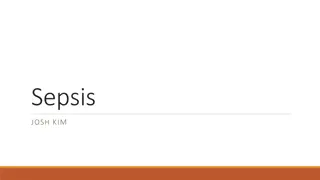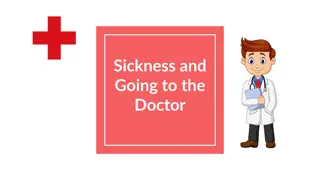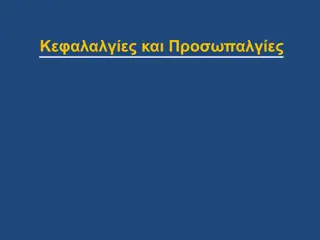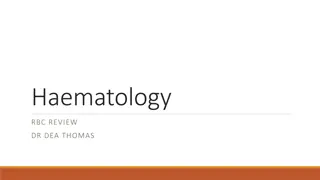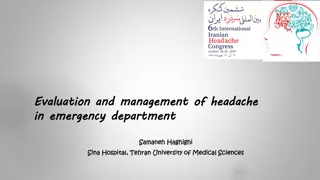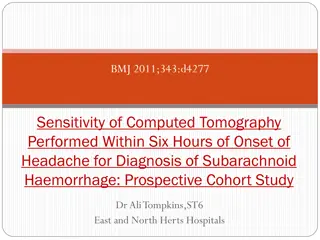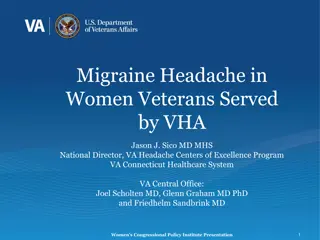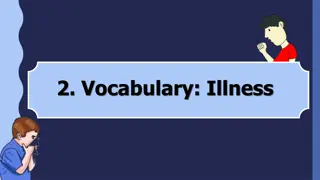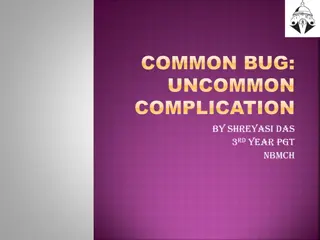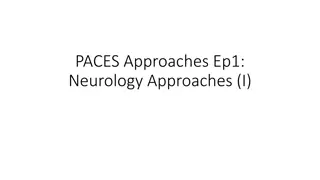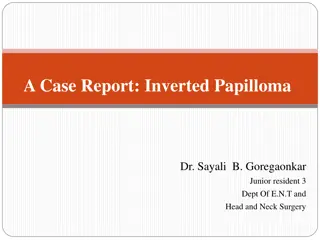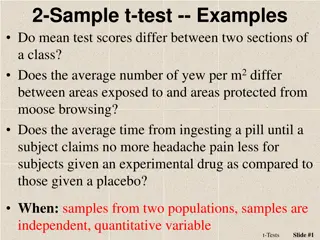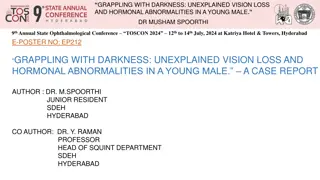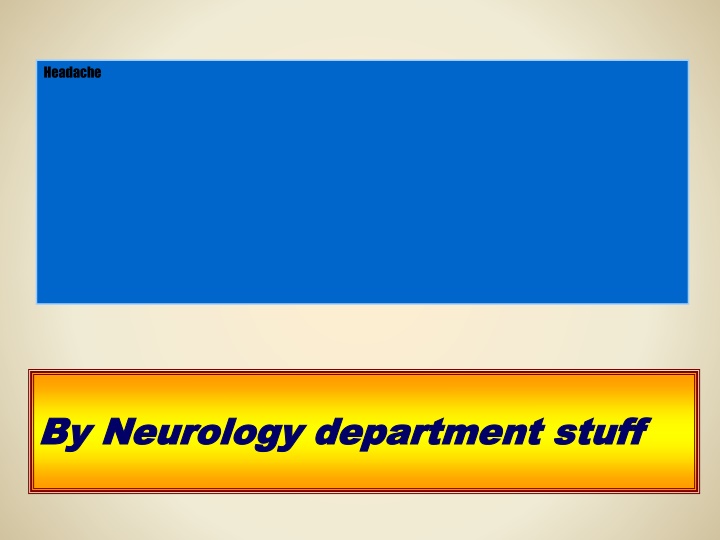
Headaches: Causes, Symptoms, and Management
Learn about headaches, a common symptom affecting the majority of the population. Discover the various types, causes, and factors contributing to headache development. Explore the importance of thorough patient history assessment and the classification of headaches for effective management.
Download Presentation

Please find below an Image/Link to download the presentation.
The content on the website is provided AS IS for your information and personal use only. It may not be sold, licensed, or shared on other websites without obtaining consent from the author. If you encounter any issues during the download, it is possible that the publisher has removed the file from their server.
You are allowed to download the files provided on this website for personal or commercial use, subject to the condition that they are used lawfully. All files are the property of their respective owners.
The content on the website is provided AS IS for your information and personal use only. It may not be sold, licensed, or shared on other websites without obtaining consent from the author.
E N D
Presentation Transcript
Headache By Neurology department stuff By Neurology department stuff
Definition Headache means pain in the head. It is a common symptom in clinical practice in 93% of males & 99% of females. It is a symptom of a disease which is in need for searching.
Every Patient with headache requires firstly history in detail : Duration of suffering from headache. Is it increasing in severity, constant or paroxysmal. Side and site of headache. Duration of each attack. Precipitating factors e.g. Cough, psychic stress etc Relieving factors e.g. Vomiting, analgesics, etc. Character of headache. Associating symptoms. History of head trauma, nasal obstruction or discharge, visual disorders, teeth problems ,...ect. 10. Is the patient anxious, tense or depressed. 11. Presence of signs of systemic disease (fever, anemia). 1. 2. 3. 4. 5. 6. 7. 8. 9.
The Mode of production of Headache All the tissues covering the cranium are pain sensitive eg; arteries, muscles and pericranium. Skull bone itself is insensitive to pain. Intracranial pain sensitive structures: Venous sinuses. Dura matter. Cerebral arteries. II, III, V, IX & X cranial nerves.
The Main factors which can cause headache: Inflammation in pain sensitive structure. Referred pain. Meningeal irritation. Traction on or dilatation of blood vessels e.g; anaemia. Pressure upon or distortion of pain sensitive structure e.g; tumors or other SOL. Psychological causes.
Classification of Headache Migraine: Tension type headache. Cluster headache: paroxysmal hemicrania). Headache associated with vascular disorders e.g.: CVS, AVM, arteritis, venous thrombosis and hypertension. Headache associated with head trauma: Acute post-traumatic headache. Chronic post-traumatic headache. Migraine without aura. Migraine with aura. Complicated migraine. (Histamine cephalgia, chronic
Headache intracranial disorders. Headache associated with non cephalic infection. Headache associated with metabolic disorders. Headache Referred from diseases of Skull bone Neck e.g. cervical spondylosis. Eyes e.g. glucoma, refractive errors. Ears e.g. OM, OE. Nose and sinuses e.g. sinusitis. Teeth, jaw and related structure disorders. Tempro-mandibular joint diseases. associated with non vascular-
Cranial neuralgia: Trigeminal neuralgia. Glossopharyngeal neuralgia. Occipital neuralgia. Optic and retrobulbar neuritis.
Distribution of symptoms in trigeminal neuralgia.
Distribution of symptoms and signs in postherpetic neuralgia.
Migraine Common in females (15-20%) than males (5-10%) Strong family history is present. Common in urban residents. Onset: at /or shortly after puberty. Frequency: May occur 2-3 times/week. Others may only have 1-2 attacks in lifetime. Frequency decrease with age. More frequent at time of menstruation. Less frequent during pregnancy.
Precipitating factors of migraine attacks : Excitation or excessive work. Menses. Bright light. Extra sleep. Strong smells. Minor trauma. Certain diets: cheese, chocolate, caffeine, alcohol, nuts, milk or missing meals. Usually headache starts gradually either preceded by aura or not, in one side then spreads to involve the whole side, some time may be bilaterally. Usually one side is commonly affected than the other.
Direction of spread (arrows) and maximal extent (colored region) of depressed cerebral blood flow (CBF) in migraine with and without aura.
Time course of changes in cerebral blood flow in migraine with aura. Timing and topography of cerebral blood flow, aura, and headache during migraine attacks
Successive maps of scintillating scotoma to show the evolution of fortification figures and associated scotoma in a patient with classic migraine.
Diagnostic criteria of migraine I- Migraine without aura: A. At least 5 attacks fulfilling B D criteria. B. Headache attacks lasting 7-48 Hs. C. Headache has at least two of the following: 1. Unilateral. 2. Pulsating. 3. Moderate / severe. 4. Aggravated by walking or any routine physical stress D. During headache at least one of the following: 1. Nausea and/or vomiting. 2. Photophobia and phonophobia.
II- Migraine with aura Usually headache attacks as migraine above beside an aura symptoms indicating focal cortical or brain stem dysfunction. Aura symptoms develops gradually over more than 4 minutes, lasting not more than 60 minutes. Headache follows aura with free interval of less than 60 minutes.
Management of Migraine I- General measures Avoidance of: Stressful situation. Mental and physical fatigue. Precipitating diet elements Dealing with other ppt. factors. II- Medical measures During the attack: Strong analgesics eg aspirin, paracetamol. Ergot preparation (e.g Migranil) oral, IM or suppository. NB: Ergot itself can cause headache in over dose and a weekly dose of 2-4 mg shouldn't be exceeded. 5HT- receptor antagonist (Sumatriptan) given in 6mg SC injection. Prostaglandin inhibitors.
III.Prophylactic measures: Ergot preparations (in closely related attacks) must be taken before the headache (in the aura) Aspirin twice daily. B-blockers eg; indral 30-120 mg/day. Ca+ channel blockers (flunarzine). Tri-cyclic antidepressants. Antihistaminic.
Tension type Headache Frequently associated with anxiety, depressive disorders and insomnia. The commonest (68% of males & 88% of females). Each attack lasts from 30 minutes up to 7 days. At least two of the following: Pressing / tightening (non-pulsating) quality. Mild or moderate. Bilateral location. No aggravation as in migraine.
Tension type Headache No nausea or vomiting. No phonophobia or photophobia. May be associated with spasm of / or tender pericranial ms. Usually ppt. by stressful situations, associated with insomnia, lost appetite. Considered chronic if persists for: More than 15 days / month or More than 6 months / year.
Distribution of symptoms and signs in tension headache.
Treatment Analgesics. Ms. Relaxants. Antidepressants. Anxiolytics.
Cluster Headache Severe unilateral orbital, supra-orbital and/or temporal pain. Lasting 15-180 minutes. Recurrent attacks over the day and may awaken the patient from sleep. Headache is associated with at least one of the following on the pain side: Lacrimation Conjunctival injection Nasal congestion Rhinorhea Miosis Ptosis Eyelid edema Forehead and facial sweating.
Distribution of symptoms and signs in cluster headache.
Treatment Strong analgesics. Ergot preparations. Antihistaminics. Non steroidal especially Endomethacine.


